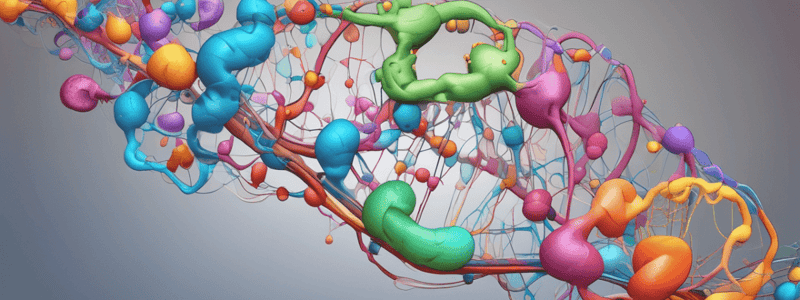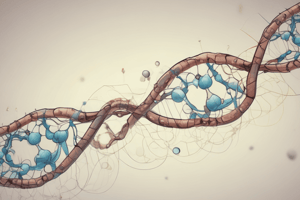Podcast
Questions and Answers
What is the primary difference between the sugar molecule found in RNA and DNA?
What is the primary difference between the sugar molecule found in RNA and DNA?
- Glucose
- Deoxyribose
- Ribose (correct)
- Fructose
What is the purpose of the sigma factor in prokaryotic transcription initiation?
What is the purpose of the sigma factor in prokaryotic transcription initiation?
- To synthesize mRNA
- To add nucleotides to the growing mRNA chain
- To unwind DNA
- To recruit RNA polymerase to the transcription start site (correct)
What is the primary function of heterogeneous nuclear RNA (hnRNA) in eukaryotic cells?
What is the primary function of heterogeneous nuclear RNA (hnRNA) in eukaryotic cells?
- To encode proteins
- To serve as a structural component of the ribosome
- To undergo co-transcriptional and post-transcriptional modifications to form mRNA (correct)
- To deliver amino acids to the ribosome
What is the direction of nucleotide addition during RNA synthesis?
What is the direction of nucleotide addition during RNA synthesis?
What is the key difference in the sugar molecule between DNA and RNA?
What is the key difference in the sugar molecule between DNA and RNA?
What is the function of ribosomal RNA (rRNA)?
What is the function of ribosomal RNA (rRNA)?
What is the main difference between prokaryotic and eukaryotic transcription?
What is the main difference between prokaryotic and eukaryotic transcription?
What is the average rate of mRNA synthesis in prokaryotes?
What is the average rate of mRNA synthesis in prokaryotes?
What is the function of transfer RNA (tRNA)?
What is the function of transfer RNA (tRNA)?
What is the purpose of the promoter region in prokaryotic transcription?
What is the purpose of the promoter region in prokaryotic transcription?
What is the sequence of the transcript produced during transcription?
What is the sequence of the transcript produced during transcription?
What is the term for the process of converting the primary transcript (hnRNA) to mature mRNA in eukaryotic cells?
What is the term for the process of converting the primary transcript (hnRNA) to mature mRNA in eukaryotic cells?
What is the primary mechanism of rho-dependent transcription termination?
What is the primary mechanism of rho-dependent transcription termination?
What is the term for the regions of DNA that are removed during RNA processing in eukaryotic cells?
What is the term for the regions of DNA that are removed during RNA processing in eukaryotic cells?
What is the function of RNA polymerase in prokaryotic transcription?
What is the function of RNA polymerase in prokaryotic transcription?
Why do GC-rich sequences cause RNA polymerase to pause?
Why do GC-rich sequences cause RNA polymerase to pause?
What is the base that replaces thymine in RNA?
What is the base that replaces thymine in RNA?
What is the function of the stem-loop structure in the mRNA transcript during rho-independent transcription termination?
What is the function of the stem-loop structure in the mRNA transcript during rho-independent transcription termination?
What is the term for the flow of genetic information from DNA to RNA to proteins?
What is the term for the flow of genetic information from DNA to RNA to proteins?
What type of bonds join nucleotides in RNA?
What type of bonds join nucleotides in RNA?
What is the purpose of rho protein in transcription termination?
What is the purpose of rho protein in transcription termination?
What is the significance of the grey boxes in the given DNA sequence?
What is the significance of the grey boxes in the given DNA sequence?
What is the function of the binding between sigma factor and the -10 and -35 boxes?
What is the function of the binding between sigma factor and the -10 and -35 boxes?
What is the location of the transcription start site?
What is the location of the transcription start site?
What is the name of the region between nucleotides 58 and 97?
What is the name of the region between nucleotides 58 and 97?
What is the function of the sequences underlined by the straight and wiggly lines?
What is the function of the sequences underlined by the straight and wiggly lines?
What are the green and blue highlighted regions?
What are the green and blue highlighted regions?
Approximately how long is the transcript (how many nucleotides)?
Approximately how long is the transcript (how many nucleotides)?
Would the mRNA sequence look like the original DNA sequence?
Would the mRNA sequence look like the original DNA sequence?
What is the function of the sigma factor?
What is the function of the sigma factor?
What is the main difference between RNA polymerase II in eukaryotes and prokaryotes?
What is the main difference between RNA polymerase II in eukaryotes and prokaryotes?
Which of the following statements is NOT true about eukaryotic transcription?
Which of the following statements is NOT true about eukaryotic transcription?
What is the purpose of the spliceosome in eukaryotic cells?
What is the purpose of the spliceosome in eukaryotic cells?
Which of the following processes occurs in the nucleus?
Which of the following processes occurs in the nucleus?
What is the term for the regions of DNA that are removed during RNA processing in eukaryotic cells?
What is the term for the regions of DNA that are removed during RNA processing in eukaryotic cells?
What is the purpose of co-transcriptional/post-transcriptional modifications in eukaryotic cells?
What is the purpose of co-transcriptional/post-transcriptional modifications in eukaryotic cells?
Flashcards are hidden until you start studying
Study Notes
Transcription and RNA Synthesis
- RNA differs from DNA in three key ways:
- RNA is single-stranded
- RNA contains ribose instead of deoxyribose
- RNA contains uracil instead of thymine
Types of RNA
- Messenger RNA (mRNA) encodes proteins
- Ribosomal RNA (rRNA) is a structural and enzymatic component of the ribosome
- Transfer RNA (tRNA) delivers amino acids to the ribosome
Transcription
- The production of messenger RNA from a DNA template
- RNA polymerase polymerizes ribonucleoside triphosphates into RNA
- The mechanism of transcription has three parts:
- Initiation
- Elongation
- Termination
Transcription in Prokaryotes
- Initiation:
- Short recognition sequences (‘boxes’) in the promoter region serve to align RNA polymerase at the transcription start site
- Sigma factor binds to the -10 (Pribnow) and -35 boxes, and recruits RNA polymerase to the transcription start site
- Elongation:
- RNA polymerase unwinds DNA as it moves
- RNA polymerase reads the DNA template, synthesizing mRNA by adding complementary nucleotides
- After the first few nucleotides are complete, the sigma factor dissociates
- Average rate of synthesis = ~50 nt/sec
- mRNA has the same sequence as the non-template (coding) strand of DNA
- Termination:
- Most common method of transcription termination in E. coli
- Termination of transcription controlled by GC-rich stop sequences in DNA
- mRNA transcript forms a stem loop, reducing binding of mRNA to DNA template
- String of weak A-U pairings help detachment from DNA template
Transcription in Eukaryotes
- Key differences from prokaryotic transcription:
- Existence of a nucleus, where transcription occurs
- Presence of multiple RNA polymerases (I, II, and III)
- RNA polymerase II synthesizes mRNA in the 5' to 3' direction
- Co-transcriptional and post-transcriptional modifications occur in eukaryotic cells
- Co-transcriptional and post-transcriptional modifications:
- Addition of a 5' cap to eukaryotic pre-mRNA
- Addition of a polyA tail to eukaryotic pre-mRNA
- Splicing, which is the removal of introns from pre-mRNA
- Export of processed mRNA into the cytoplasm
Exons and Introns
- Exons: regions of the primary transcript that are retained in the mature mRNA
- Introns: regions of the primary transcript that are removed during splicing
Studying That Suits You
Use AI to generate personalized quizzes and flashcards to suit your learning preferences.




